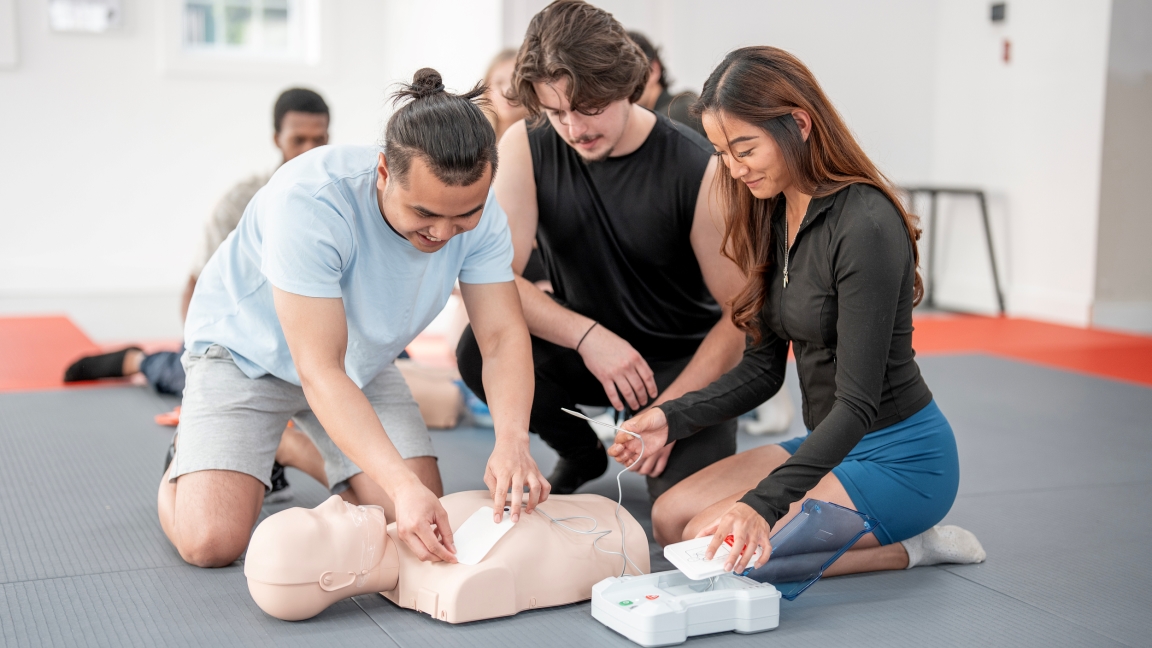
Consider this: a person collapses in a mall, a passenger faints on the subway, or an athlete has a seizure during a game. Sudden cardiac arrest requires action within 4 minutes for effective rescue. Each minute of delay reduces survival chances by 10 percent. You have 4 to 6 minutes to act.
People often hesitate in these situations; they want to help but are unsure how to proceed or fear stepping in. This is where the "life-saving device" AED comes in. It can reverse the crisis, and notably, non-medical personnel can use it easily.
![[Explainer] Golden 4 minutes: How to locate and use an AED quickly](https://obj.shine.cn/files/2025/09/04/9671eb20-09eb-42ba-92b7-f385821ad1f9_0.jpg)
They practice AED training with mannequins
What is an AED?
AED stands for Automated External Defibrillator. It is a medical device used to rescue patients suffering from sudden cardiac arrest (such as heart attacks).
Keep in mind: if you can't perform rescue breaths or if no AED is available, continuous chest compressions are still effective.
![[Explainer] Golden 4 minutes: How to locate and use an AED quickly](https://obj.shine.cn/files/2025/09/03/11a71225-763a-464d-bac5-2f781b305762_0.jpeg)
AED on Metro Line 8
How to Locate an AED?
AEDs are usually stored in wall-mounted red or orange boxes, marked with a clear white heart-and-lightning-bolt symbol and the letters "AED."
So, when an emergency happens, how can you quickly find one?
Method 1: Check Common Fixed Locations
- Subway stations: near security checkpoints, customer service counters
- Shopping malls: information desks, elevator lobbies, restrooms
- Parks & scenic areas: visitor centers, service stations
- Schools: school clinic, sports hall entrances
- Office buildings: main lobby reception, near fire hydrants
- Gyms: poolside areas, walls around equipment zones
![[Explainer] Golden 4 minutes: How to locate and use an AED quickly](https://obj.shine.cn/files/2025/09/03/d36ae6d3-1b60-437e-a055-476c286ecfc0_0.jpeg)
You can find AEDs in some common fixed locations
Method 2: Ask or Look Around
In crowded public places (malls, stations, arenas), immediately ask security staff, customer service, or nearby employees. They usually know the AED's exact location and can fetch it quickly.
If no one is available, scan the surroundings – focus first on places like residential compound entrances, subway stations, and sports venues.
![[Explainer] Golden 4 minutes: How to locate and use an AED quickly](https://obj.shine.cn/files/2025/09/04/11d419d6-01ce-46f3-834b-01d501af349a_0.jpg)
Look for this sign
Method 3: Search Online
Since 2017, the Red Cross Society of China Shanghai Branch and Shanghai Medical Emergency Center have jointly launched an AED map.
AED locations are marked in red and green. On WeChat, search for the mini-program "AED Emergency Map" (AED急救地图) or "Shanghai AED Map" (上海AED地图) to find the nearest one by location.
![[Explainer] Golden 4 minutes: How to locate and use an AED quickly](https://obj.shine.cn/files/2025/09/03/8b1dda5c-8596-451d-b7e1-b054e2612cd4_0.jpeg)
In the WeChat search bar, look for "AED Emergency Map"
![[Explainer] Golden 4 minutes: How to locate and use an AED quickly](https://obj.shine.cn/files/2025/09/03/d0dbca32-8b39-41cb-87e1-a0560c4ee4a2_0.jpeg)
The map shows where AEDs are located near your current position.
How to Use an AED?
Step 1: Turn on the AED
Switch on the device (on some models, simply opening the lid turns it on). Follow the voice instructions.
Step 2: Attach the electrode pads
Expose the patient's chest. Place the pads directly on bare skin and connect the plug (some models have pre-connected plugs).
Follow the diagram on the pads or device:
- One pad below the right collarbone
- The other on the left side of the chest, below the nipple
For children under 8 years old or weighing less than 25kg: use pediatric pads or the child mode. If the child is small, you can place one pad on the center of the chest and the other on the center of the back (to avoid overlap).
If pediatric pads are unavailable, adult pads can still be used.
![[Explainer] Golden 4 minutes: How to locate and use an AED quickly](https://obj.shine.cn/files/2025/09/03/e424e402-959e-4e76-8943-08f37a4288a1_0.jpg)
Attach the pads as shown in the diagram
Step 3: Analyze the heart rhythm
Once connected, the AED will automatically analyze the heart rhythm. No one should touch the patient to avoid interfering with the heart rhythm analysis.
Every two minutes, the AED will automatically re-analyze and, if necessary, advise another shock.
Step 4: Deliver a shock (if needed)
If a shockable rhythm is detected, the AED will automatically charge and announce: "Charging, do not touch the patient."
Confirm no one is in contact, then press the shock button once the AED has finished charging and the indicator is flashing continuously. You may notice a brief episode of muscle rigidity in the patient caused by the shock.
If the rhythm is not shockable, the AED will announce: "No shock advised. Continue CPR (Cardio Pulmonary Resuscitation)."
![[Explainer] Golden 4 minutes: How to locate and use an AED quickly](https://obj.shine.cn/files/2025/09/03/6c68f82c-df24-45f1-b024-4bf085d8e0ce_0.jpg)
When the AED is analyzing the heart rhythm, everyone must stand clear to avoid interfering with the assessment
In addition to the AED instructions above, you also need to be aware of the core principles and safety guidelines for cardiac arrest first aid.
1. Check the Environment First
Always make sure it's safe for you, the patient, and others. If not safe, move the patient to a safer spot before attempting rescue (if possible without delay).
2. Recognize Cardiac Arrest
Only use an AED if the patient is unresponsive and not breathing (or only agonal breathing).
If you're unsure, don't worry – the AED will only shock when needed. Using it incorrectly won't harm the patient.
3. Continue CPR
AED use does not replace CPR, so continue performing high-quality chest compressions before the AED arrives, throughout setup and pad placement, and immediately after each shock – or when no shock is advised.
4. Follow the AED's Voice Prompts
When the AED is analyzing the heart rhythm or delivering a shock and says "Do not touch the patient," stop CPR and make sure no one is in contact with the patient.

